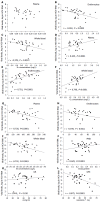Blood micronutrient, oxidative stress, and viral load in patients with chronic hepatitis C
- PMID: 16094713
- PMCID: PMC4615414
- DOI: 10.3748/wjg.v11.i30.4697
Blood micronutrient, oxidative stress, and viral load in patients with chronic hepatitis C
Abstract
Aim: To assess the extent of micronutrient and oxidative stress in blood and to examine their linkages with viral loads in chronic hepatitis C patients.
Methods: Hepatitis C virus (HCV)-RNA levels were quantified in the serum from 37 previously untreated patients with chronic hepatitis C. The plasma and erythrocyte micronutrients (zinc, selenium, copper, and iron) were estimated, and malondialdehyde (MDA) contents were determined as a marker to detect oxidative stress. Antioxidant enzymes, superoxide dismutase (SOD), glutathione peroxidase (GPX) and glutathione reductase (GR) activities in blood were also measured. The control group contained 31 healthy volunteers.
Results: The contents of zinc (Zn), and selenium (Se) in plasma and erythrocytes were significantly lower in hepatitis C patients than in the controls. On the contrary, copper (Cu) levels were significantly higher. Furthermore, plasma and erythrocyte MDA levels, and the SOD and GR activities in erythrocytes significantly increased in hepatitis C patients compared to the controls. However, the plasma GPX activity in patients was markedly lower. Plasma Se (r = -0.730, P<0.05), Cu (r = 0.635), and GPX (r = -0.675) demonstrated correlations with HCV-RNA loads. Significant correlation coefficients were also observed between HCV-RNA levels and erythrocyte Zn (r = -0.403), Se (r = -0.544), Cu (r = 0.701) and MDA (r = 0.629) and GR (r = 0.441).
Conclusion: The levels of Zn, Se, Cu, and oxidative stress (MDA), as well as related anti-oxidative enzymes (GR and GPX) in blood have important impact on the viral factors in chronic hepatitis C. The distribution of these parameters might be significant biomarkers for HCV.
Figures

Similar articles
-
Copper/zinc and copper/selenium ratios, and oxidative stress as biochemical markers in recurrent aphthous stomatitis.J Trace Elem Med Biol. 2013 Oct;27(4):312-6. doi: 10.1016/j.jtemb.2013.04.002. Epub 2013 Apr 12. J Trace Elem Med Biol. 2013. PMID: 23664921
-
[The effect of hemodialysis on some parameters of the antioxidant system in the blood of patients with chronic renal failure].Ann Acad Med Stetin. 2004;50(1):41-52. Ann Acad Med Stetin. 2004. PMID: 16871743 Clinical Trial. Polish.
-
The association of oxidant-antioxidant status in patients with chronic renal failure.Ren Fail. 2016;38(1):20-6. doi: 10.3109/0886022X.2015.1103654. Epub 2015 Nov 2. Ren Fail. 2016. PMID: 26524399
-
[Investigation of oxidative stress and antioxidant defense in patients with hepatitis B virus infection and the effect of interferon-alpha plus lamivudine combination therapy on oxidative stress].Mikrobiyol Bul. 2009 Jul;43(3):411-23. Mikrobiyol Bul. 2009. PMID: 19795616 Turkish.
-
The Status of Oxidative Stress in Patients with Alcohol Dependence: A Meta-Analysis.Antioxidants (Basel). 2022 Sep 28;11(10):1919. doi: 10.3390/antiox11101919. Antioxidants (Basel). 2022. PMID: 36290642 Free PMC article. Review.
Cited by
-
Status of essential trace minerals and oxidative stress in viral hepatitis C patients with nonalcoholic fatty liver disease.Int J Med Sci. 2013 Apr 17;10(6):730-7. doi: 10.7150/ijms.6104. Print 2013. Int J Med Sci. 2013. PMID: 23630437 Free PMC article.
-
Regression of Nonalcoholic Fatty Liver Disease with Zinc and Selenium Co-supplementation after Disease Progression in Rats.Iran J Med Sci. 2018 Jan;43(1):26-31. Iran J Med Sci. 2018. PMID: 29398749 Free PMC article.
-
Interactions between Hepatitis C Virus and the Human Apolipoprotein H Acute Phase Protein: A Tool for a Sensitive Detection of the Virus.PLoS One. 2015 Oct 26;10(10):e0140900. doi: 10.1371/journal.pone.0140900. eCollection 2015. PLoS One. 2015. PMID: 26502286 Free PMC article.
-
Selenium, Selenoproteins, and Immunity.Nutrients. 2018 Sep 1;10(9):1203. doi: 10.3390/nu10091203. Nutrients. 2018. PMID: 30200430 Free PMC article. Review.
-
Circulating copper and zinc levels and risk of hepatobiliary cancers in Europeans.Br J Cancer. 2017 Feb 28;116(5):688-696. doi: 10.1038/bjc.2017.1. Epub 2017 Feb 2. Br J Cancer. 2017. PMID: 28152549 Free PMC article.
References
Publication types
MeSH terms
Substances
LinkOut - more resources
Full Text Sources
Other Literature Sources

